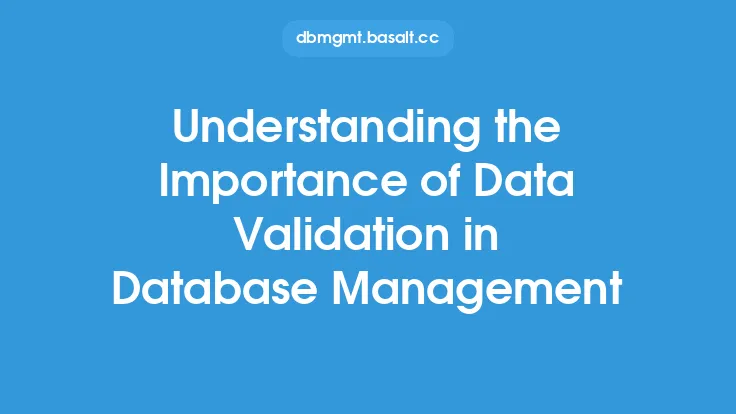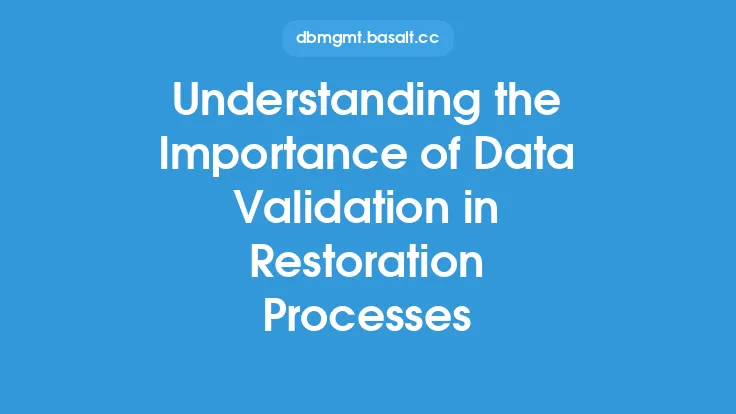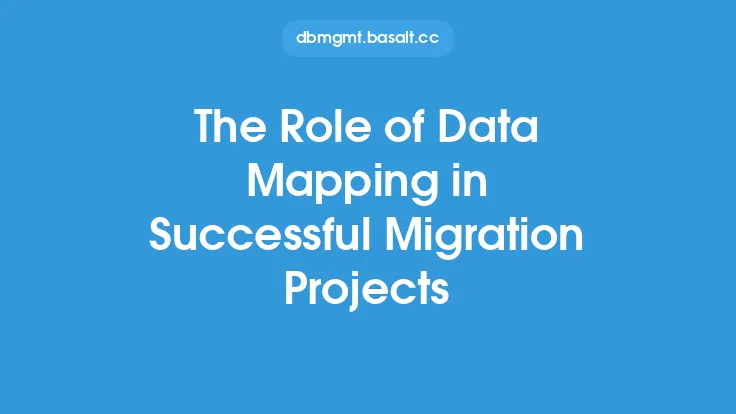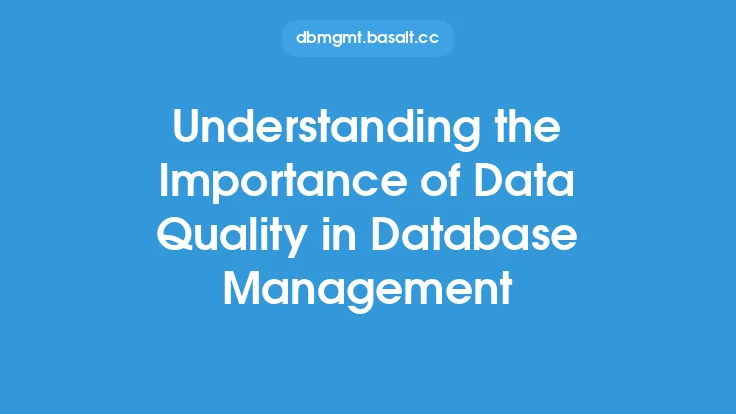Data migration is a complex process that involves transferring data from one system, format, or storage device to another. It is a critical aspect of database implementation, as it enables organizations to upgrade their systems, switch to new technologies, or consolidate their data. However, data migration can be a risky and error-prone process, especially if the data being migrated is not properly validated. Data validation is the process of checking the data for accuracy, completeness, and consistency to ensure that it is correct and usable. In the context of data migration, data validation is crucial to ensure that the data being transferred is accurate, complete, and consistent with the requirements of the target system.
Introduction to Data Validation
Data validation involves checking the data against a set of predefined rules, constraints, and formats to ensure that it meets the required standards. It is an essential step in the data migration process, as it helps to identify and correct errors, inconsistencies, and inaccuracies in the data. Data validation can be performed manually or automatically, depending on the size and complexity of the data being migrated. Manual validation involves manually checking the data against the predefined rules and constraints, while automatic validation involves using software tools and algorithms to check the data.
Types of Data Validation
There are several types of data validation that can be performed during data migration, including:
- Format validation: This involves checking the data to ensure that it is in the correct format, such as date, time, or numeric format.
- Range validation: This involves checking the data to ensure that it falls within a specified range, such as a valid age range or a valid salary range.
- Pattern validation: This involves checking the data to ensure that it matches a specified pattern, such as a phone number or an email address.
- Cross-validation: This involves checking the data against other data elements to ensure that it is consistent and accurate.
- Business rule validation: This involves checking the data against business rules and constraints to ensure that it is valid and consistent with the organization's policies and procedures.
Benefits of Data Validation
Data validation offers several benefits, including:
- Improved data quality: Data validation helps to ensure that the data being migrated is accurate, complete, and consistent, which improves the overall quality of the data.
- Reduced errors: Data validation helps to identify and correct errors, inconsistencies, and inaccuracies in the data, which reduces the risk of errors and exceptions during the migration process.
- Increased efficiency: Data validation helps to automate the data migration process, which increases efficiency and reduces the time and effort required to complete the migration.
- Better decision-making: Data validation helps to ensure that the data being migrated is accurate and reliable, which enables better decision-making and improved business outcomes.
Challenges of Data Validation
Data validation can be a challenging process, especially when dealing with large and complex datasets. Some of the common challenges of data validation include:
- Data complexity: Large and complex datasets can be difficult to validate, especially if they contain multiple data elements and relationships.
- Data inconsistency: Inconsistent data can be difficult to validate, especially if it contains errors, exceptions, or inconsistencies.
- Limited resources: Data validation can require significant resources, including time, effort, and budget, which can be a challenge for organizations with limited resources.
- Technical issues: Technical issues, such as software compatibility problems or data format issues, can make it difficult to validate the data.
Best Practices for Data Validation
To ensure effective data validation, organizations should follow best practices, including:
- Develop a data validation plan: Develop a plan that outlines the data validation process, including the rules, constraints, and formats to be used.
- Use automated validation tools: Use automated validation tools and software to validate the data, especially for large and complex datasets.
- Test and validate the data: Test and validate the data thoroughly to ensure that it is accurate, complete, and consistent.
- Document the validation process: Document the validation process, including the rules, constraints, and formats used, to ensure that the process is transparent and repeatable.
- Continuously monitor and improve: Continuously monitor and improve the data validation process to ensure that it is effective and efficient.
Tools and Technologies for Data Validation
There are several tools and technologies available for data validation, including:
- Data validation software: Software tools, such as data validation frameworks and libraries, can be used to validate the data.
- Data quality tools: Data quality tools, such as data profiling and data cleansing tools, can be used to validate the data.
- Database management systems: Database management systems, such as relational databases and NoSQL databases, can be used to validate the data.
- Data integration tools: Data integration tools, such as ETL (Extract, Transform, Load) tools, can be used to validate the data during the migration process.
Conclusion
Data validation is a critical aspect of data migration, as it ensures that the data being transferred is accurate, complete, and consistent. By following best practices and using the right tools and technologies, organizations can ensure effective data validation and improve the overall quality of their data. Whether migrating data to a new system, consolidating data from multiple sources, or upgrading to a new technology, data validation is essential to ensure that the data is accurate, reliable, and usable. By prioritizing data validation, organizations can reduce the risk of errors and exceptions, improve efficiency, and enable better decision-making.





